Pressure Injury Case Study: Prevention and Care Plan for ICU Patient
VerifiedAdded on 2023/04/21
|7
|1971
|361
Case Study
AI Summary
This case study examines pressure injuries in ICU patients, focusing on the case of Joseph Russo, who developed a pressure ulcer on his heel during his ICU stay. The essay explores the literature on pressure injuries, including their causes, risk factors, and management strategies, particularly for ICU patients. It highlights the importance of skin integrity assessment, infection control, and preventative measures like regular posture changes and specialized bedding. The case study concludes with a detailed care plan for Joseph, emphasizing infection control, wound dressing, and patient education, to ensure a comfortable and speedy recovery. Desklib provides this document and many other resources to help students.
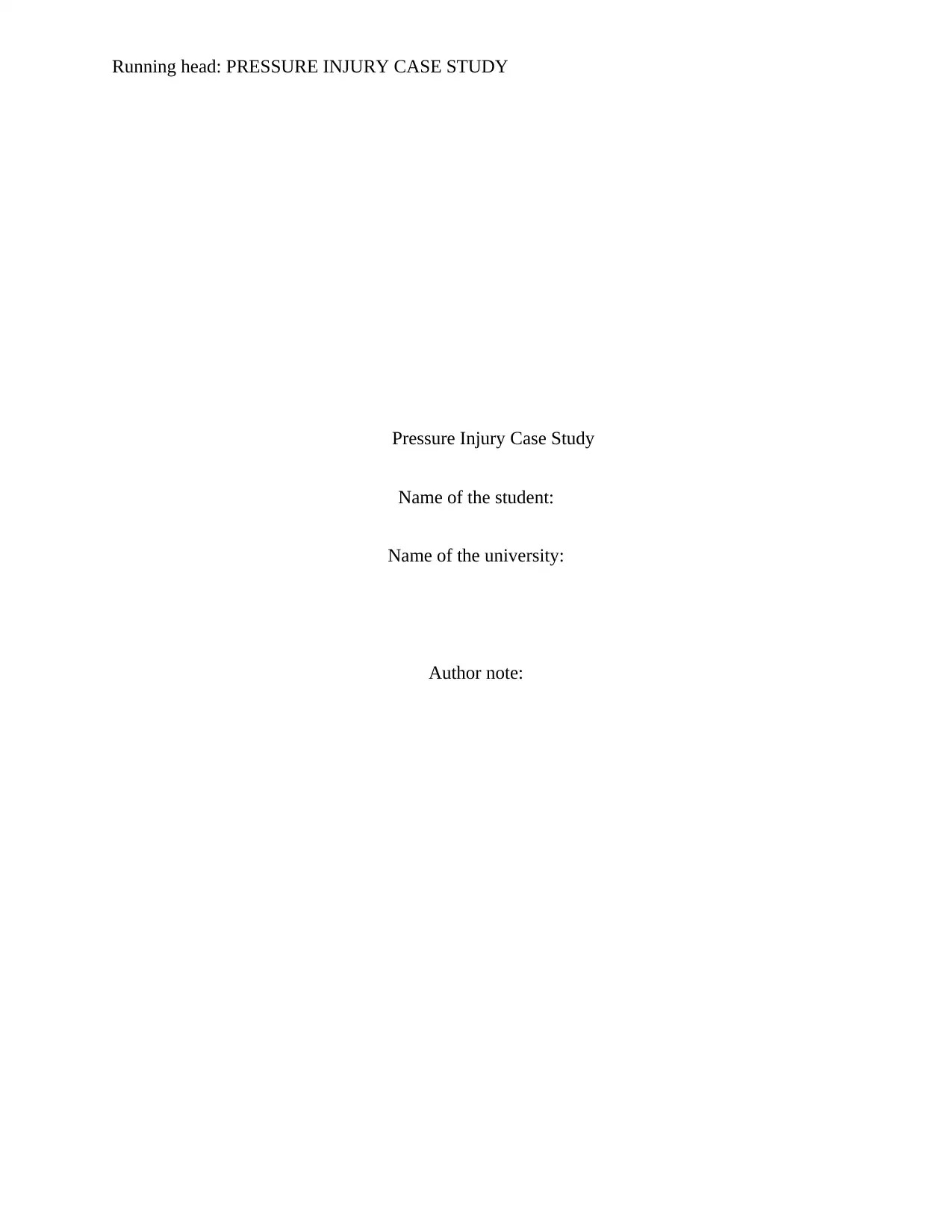
Running head: PRESSURE INJURY CASE STUDY
Pressure Injury Case Study
Name of the student:
Name of the university:
Author note:
Pressure Injury Case Study
Name of the student:
Name of the university:
Author note:
Paraphrase This Document
Need a fresh take? Get an instant paraphrase of this document with our AI Paraphraser
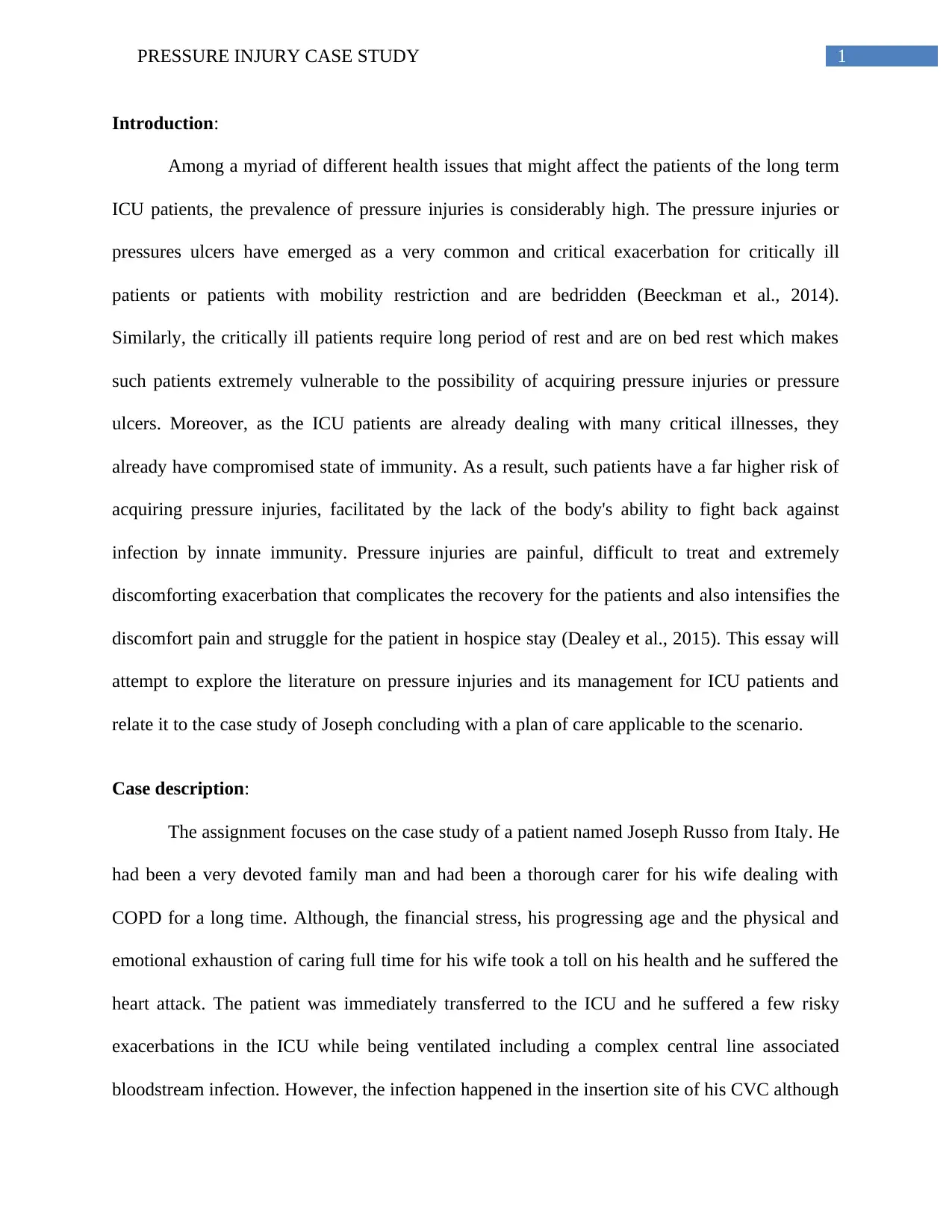
1PRESSURE INJURY CASE STUDY
Introduction:
Among a myriad of different health issues that might affect the patients of the long term
ICU patients, the prevalence of pressure injuries is considerably high. The pressure injuries or
pressures ulcers have emerged as a very common and critical exacerbation for critically ill
patients or patients with mobility restriction and are bedridden (Beeckman et al., 2014).
Similarly, the critically ill patients require long period of rest and are on bed rest which makes
such patients extremely vulnerable to the possibility of acquiring pressure injuries or pressure
ulcers. Moreover, as the ICU patients are already dealing with many critical illnesses, they
already have compromised state of immunity. As a result, such patients have a far higher risk of
acquiring pressure injuries, facilitated by the lack of the body's ability to fight back against
infection by innate immunity. Pressure injuries are painful, difficult to treat and extremely
discomforting exacerbation that complicates the recovery for the patients and also intensifies the
discomfort pain and struggle for the patient in hospice stay (Dealey et al., 2015). This essay will
attempt to explore the literature on pressure injuries and its management for ICU patients and
relate it to the case study of Joseph concluding with a plan of care applicable to the scenario.
Case description:
The assignment focuses on the case study of a patient named Joseph Russo from Italy. He
had been a very devoted family man and had been a thorough carer for his wife dealing with
COPD for a long time. Although, the financial stress, his progressing age and the physical and
emotional exhaustion of caring full time for his wife took a toll on his health and he suffered the
heart attack. The patient was immediately transferred to the ICU and he suffered a few risky
exacerbations in the ICU while being ventilated including a complex central line associated
bloodstream infection. However, the infection happened in the insertion site of his CVC although
Introduction:
Among a myriad of different health issues that might affect the patients of the long term
ICU patients, the prevalence of pressure injuries is considerably high. The pressure injuries or
pressures ulcers have emerged as a very common and critical exacerbation for critically ill
patients or patients with mobility restriction and are bedridden (Beeckman et al., 2014).
Similarly, the critically ill patients require long period of rest and are on bed rest which makes
such patients extremely vulnerable to the possibility of acquiring pressure injuries or pressure
ulcers. Moreover, as the ICU patients are already dealing with many critical illnesses, they
already have compromised state of immunity. As a result, such patients have a far higher risk of
acquiring pressure injuries, facilitated by the lack of the body's ability to fight back against
infection by innate immunity. Pressure injuries are painful, difficult to treat and extremely
discomforting exacerbation that complicates the recovery for the patients and also intensifies the
discomfort pain and struggle for the patient in hospice stay (Dealey et al., 2015). This essay will
attempt to explore the literature on pressure injuries and its management for ICU patients and
relate it to the case study of Joseph concluding with a plan of care applicable to the scenario.
Case description:
The assignment focuses on the case study of a patient named Joseph Russo from Italy. He
had been a very devoted family man and had been a thorough carer for his wife dealing with
COPD for a long time. Although, the financial stress, his progressing age and the physical and
emotional exhaustion of caring full time for his wife took a toll on his health and he suffered the
heart attack. The patient was immediately transferred to the ICU and he suffered a few risky
exacerbations in the ICU while being ventilated including a complex central line associated
bloodstream infection. However, the infection happened in the insertion site of his CVC although
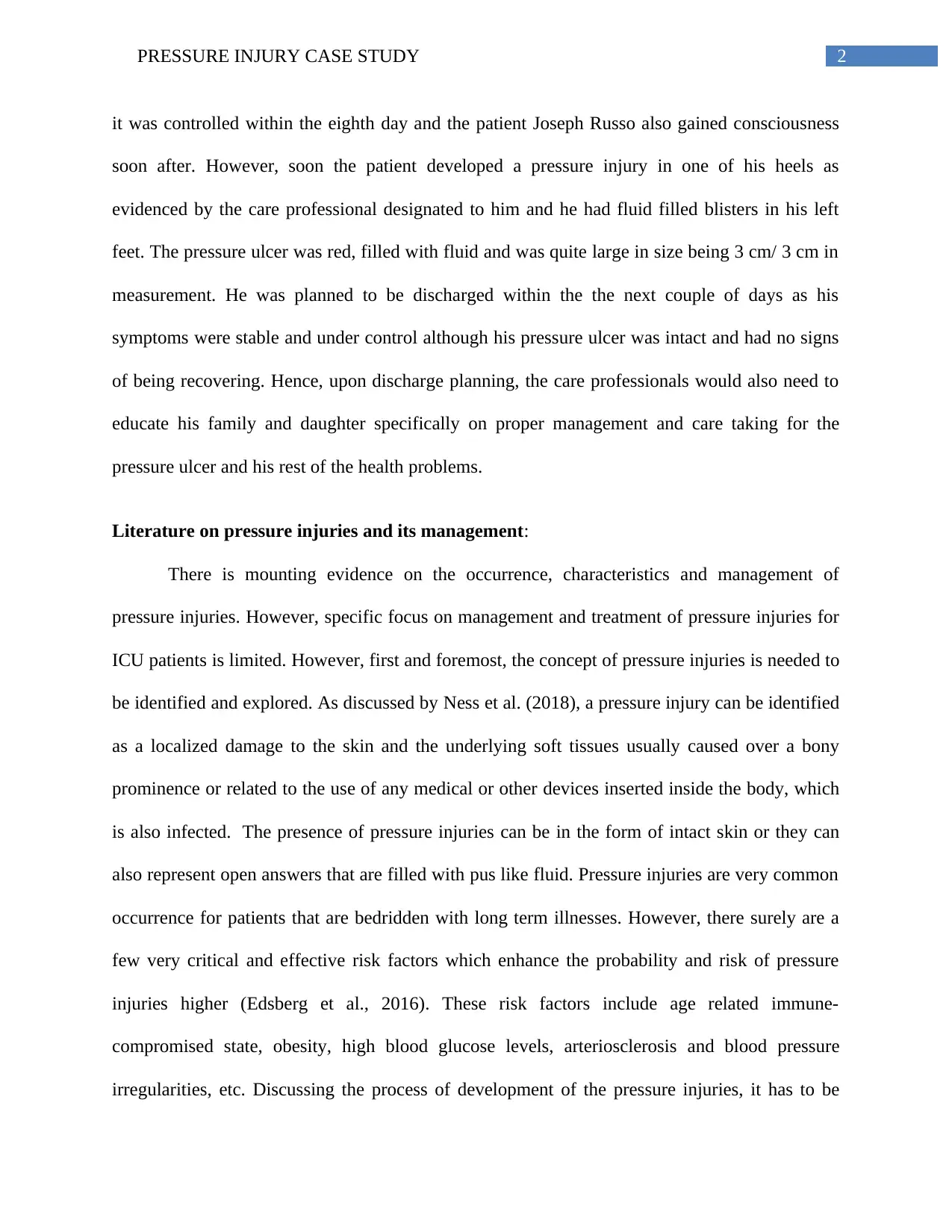
2PRESSURE INJURY CASE STUDY
it was controlled within the eighth day and the patient Joseph Russo also gained consciousness
soon after. However, soon the patient developed a pressure injury in one of his heels as
evidenced by the care professional designated to him and he had fluid filled blisters in his left
feet. The pressure ulcer was red, filled with fluid and was quite large in size being 3 cm/ 3 cm in
measurement. He was planned to be discharged within the the next couple of days as his
symptoms were stable and under control although his pressure ulcer was intact and had no signs
of being recovering. Hence, upon discharge planning, the care professionals would also need to
educate his family and daughter specifically on proper management and care taking for the
pressure ulcer and his rest of the health problems.
Literature on pressure injuries and its management:
There is mounting evidence on the occurrence, characteristics and management of
pressure injuries. However, specific focus on management and treatment of pressure injuries for
ICU patients is limited. However, first and foremost, the concept of pressure injuries is needed to
be identified and explored. As discussed by Ness et al. (2018), a pressure injury can be identified
as a localized damage to the skin and the underlying soft tissues usually caused over a bony
prominence or related to the use of any medical or other devices inserted inside the body, which
is also infected. The presence of pressure injuries can be in the form of intact skin or they can
also represent open answers that are filled with pus like fluid. Pressure injuries are very common
occurrence for patients that are bedridden with long term illnesses. However, there surely are a
few very critical and effective risk factors which enhance the probability and risk of pressure
injuries higher (Edsberg et al., 2016). These risk factors include age related immune-
compromised state, obesity, high blood glucose levels, arteriosclerosis and blood pressure
irregularities, etc. Discussing the process of development of the pressure injuries, it has to be
it was controlled within the eighth day and the patient Joseph Russo also gained consciousness
soon after. However, soon the patient developed a pressure injury in one of his heels as
evidenced by the care professional designated to him and he had fluid filled blisters in his left
feet. The pressure ulcer was red, filled with fluid and was quite large in size being 3 cm/ 3 cm in
measurement. He was planned to be discharged within the the next couple of days as his
symptoms were stable and under control although his pressure ulcer was intact and had no signs
of being recovering. Hence, upon discharge planning, the care professionals would also need to
educate his family and daughter specifically on proper management and care taking for the
pressure ulcer and his rest of the health problems.
Literature on pressure injuries and its management:
There is mounting evidence on the occurrence, characteristics and management of
pressure injuries. However, specific focus on management and treatment of pressure injuries for
ICU patients is limited. However, first and foremost, the concept of pressure injuries is needed to
be identified and explored. As discussed by Ness et al. (2018), a pressure injury can be identified
as a localized damage to the skin and the underlying soft tissues usually caused over a bony
prominence or related to the use of any medical or other devices inserted inside the body, which
is also infected. The presence of pressure injuries can be in the form of intact skin or they can
also represent open answers that are filled with pus like fluid. Pressure injuries are very common
occurrence for patients that are bedridden with long term illnesses. However, there surely are a
few very critical and effective risk factors which enhance the probability and risk of pressure
injuries higher (Edsberg et al., 2016). These risk factors include age related immune-
compromised state, obesity, high blood glucose levels, arteriosclerosis and blood pressure
irregularities, etc. Discussing the process of development of the pressure injuries, it has to be
⊘ This is a preview!⊘
Do you want full access?
Subscribe today to unlock all pages.

Trusted by 1+ million students worldwide
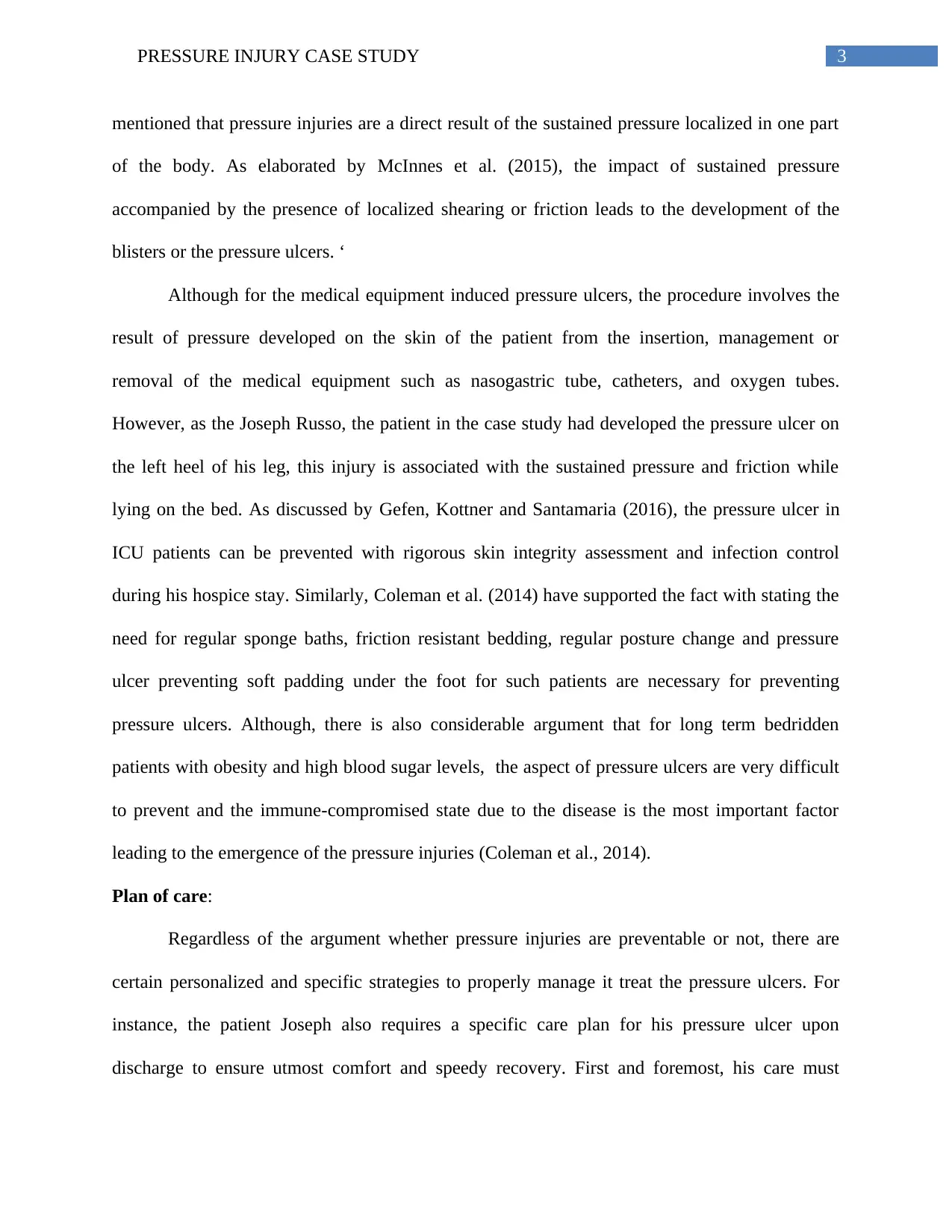
3PRESSURE INJURY CASE STUDY
mentioned that pressure injuries are a direct result of the sustained pressure localized in one part
of the body. As elaborated by McInnes et al. (2015), the impact of sustained pressure
accompanied by the presence of localized shearing or friction leads to the development of the
blisters or the pressure ulcers. ‘
Although for the medical equipment induced pressure ulcers, the procedure involves the
result of pressure developed on the skin of the patient from the insertion, management or
removal of the medical equipment such as nasogastric tube, catheters, and oxygen tubes.
However, as the Joseph Russo, the patient in the case study had developed the pressure ulcer on
the left heel of his leg, this injury is associated with the sustained pressure and friction while
lying on the bed. As discussed by Gefen, Kottner and Santamaria (2016), the pressure ulcer in
ICU patients can be prevented with rigorous skin integrity assessment and infection control
during his hospice stay. Similarly, Coleman et al. (2014) have supported the fact with stating the
need for regular sponge baths, friction resistant bedding, regular posture change and pressure
ulcer preventing soft padding under the foot for such patients are necessary for preventing
pressure ulcers. Although, there is also considerable argument that for long term bedridden
patients with obesity and high blood sugar levels, the aspect of pressure ulcers are very difficult
to prevent and the immune-compromised state due to the disease is the most important factor
leading to the emergence of the pressure injuries (Coleman et al., 2014).
Plan of care:
Regardless of the argument whether pressure injuries are preventable or not, there are
certain personalized and specific strategies to properly manage it treat the pressure ulcers. For
instance, the patient Joseph also requires a specific care plan for his pressure ulcer upon
discharge to ensure utmost comfort and speedy recovery. First and foremost, his care must
mentioned that pressure injuries are a direct result of the sustained pressure localized in one part
of the body. As elaborated by McInnes et al. (2015), the impact of sustained pressure
accompanied by the presence of localized shearing or friction leads to the development of the
blisters or the pressure ulcers. ‘
Although for the medical equipment induced pressure ulcers, the procedure involves the
result of pressure developed on the skin of the patient from the insertion, management or
removal of the medical equipment such as nasogastric tube, catheters, and oxygen tubes.
However, as the Joseph Russo, the patient in the case study had developed the pressure ulcer on
the left heel of his leg, this injury is associated with the sustained pressure and friction while
lying on the bed. As discussed by Gefen, Kottner and Santamaria (2016), the pressure ulcer in
ICU patients can be prevented with rigorous skin integrity assessment and infection control
during his hospice stay. Similarly, Coleman et al. (2014) have supported the fact with stating the
need for regular sponge baths, friction resistant bedding, regular posture change and pressure
ulcer preventing soft padding under the foot for such patients are necessary for preventing
pressure ulcers. Although, there is also considerable argument that for long term bedridden
patients with obesity and high blood sugar levels, the aspect of pressure ulcers are very difficult
to prevent and the immune-compromised state due to the disease is the most important factor
leading to the emergence of the pressure injuries (Coleman et al., 2014).
Plan of care:
Regardless of the argument whether pressure injuries are preventable or not, there are
certain personalized and specific strategies to properly manage it treat the pressure ulcers. For
instance, the patient Joseph also requires a specific care plan for his pressure ulcer upon
discharge to ensure utmost comfort and speedy recovery. First and foremost, his care must
Paraphrase This Document
Need a fresh take? Get an instant paraphrase of this document with our AI Paraphraser
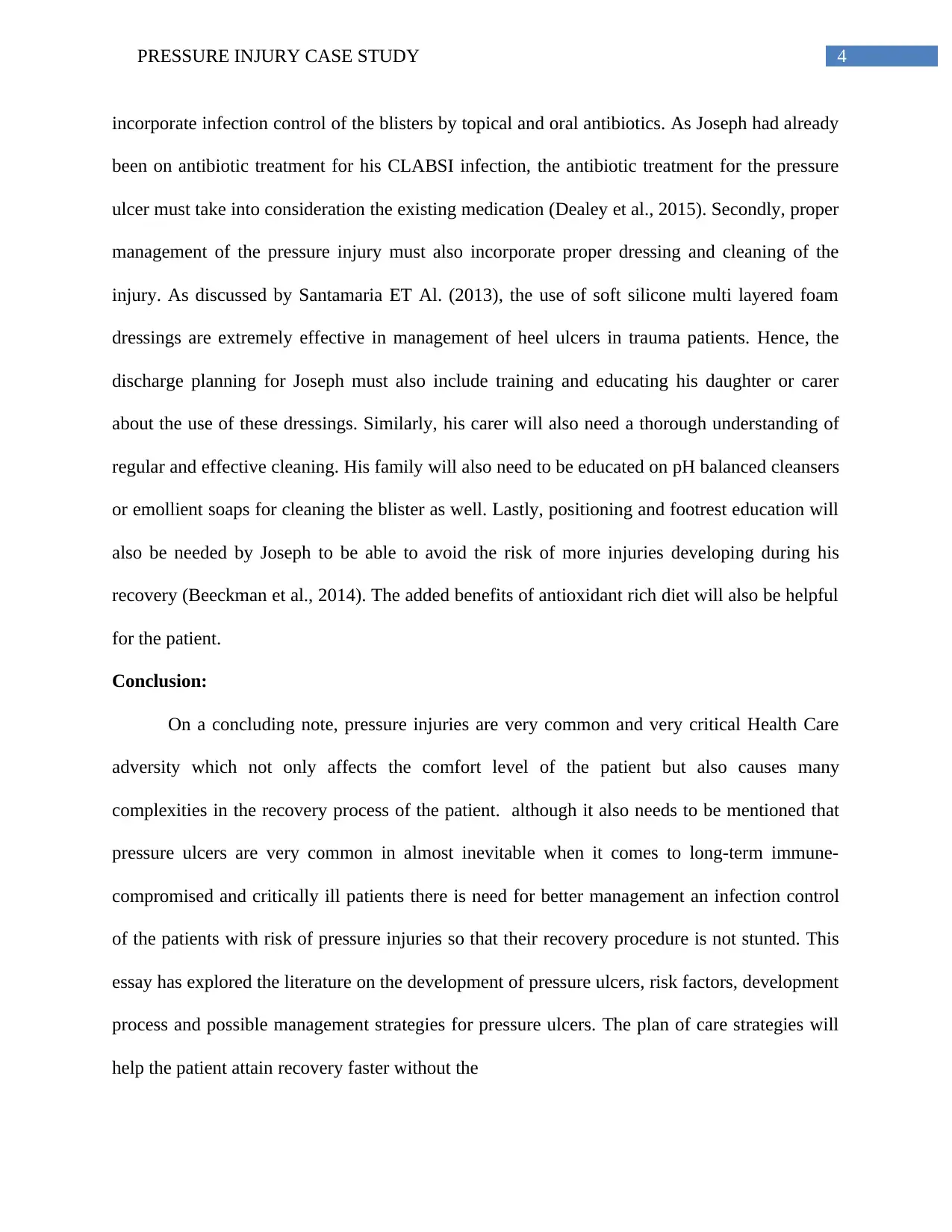
4PRESSURE INJURY CASE STUDY
incorporate infection control of the blisters by topical and oral antibiotics. As Joseph had already
been on antibiotic treatment for his CLABSI infection, the antibiotic treatment for the pressure
ulcer must take into consideration the existing medication (Dealey et al., 2015). Secondly, proper
management of the pressure injury must also incorporate proper dressing and cleaning of the
injury. As discussed by Santamaria ET Al. (2013), the use of soft silicone multi layered foam
dressings are extremely effective in management of heel ulcers in trauma patients. Hence, the
discharge planning for Joseph must also include training and educating his daughter or carer
about the use of these dressings. Similarly, his carer will also need a thorough understanding of
regular and effective cleaning. His family will also need to be educated on pH balanced cleansers
or emollient soaps for cleaning the blister as well. Lastly, positioning and footrest education will
also be needed by Joseph to be able to avoid the risk of more injuries developing during his
recovery (Beeckman et al., 2014). The added benefits of antioxidant rich diet will also be helpful
for the patient.
Conclusion:
On a concluding note, pressure injuries are very common and very critical Health Care
adversity which not only affects the comfort level of the patient but also causes many
complexities in the recovery process of the patient. although it also needs to be mentioned that
pressure ulcers are very common in almost inevitable when it comes to long-term immune-
compromised and critically ill patients there is need for better management an infection control
of the patients with risk of pressure injuries so that their recovery procedure is not stunted. This
essay has explored the literature on the development of pressure ulcers, risk factors, development
process and possible management strategies for pressure ulcers. The plan of care strategies will
help the patient attain recovery faster without the
incorporate infection control of the blisters by topical and oral antibiotics. As Joseph had already
been on antibiotic treatment for his CLABSI infection, the antibiotic treatment for the pressure
ulcer must take into consideration the existing medication (Dealey et al., 2015). Secondly, proper
management of the pressure injury must also incorporate proper dressing and cleaning of the
injury. As discussed by Santamaria ET Al. (2013), the use of soft silicone multi layered foam
dressings are extremely effective in management of heel ulcers in trauma patients. Hence, the
discharge planning for Joseph must also include training and educating his daughter or carer
about the use of these dressings. Similarly, his carer will also need a thorough understanding of
regular and effective cleaning. His family will also need to be educated on pH balanced cleansers
or emollient soaps for cleaning the blister as well. Lastly, positioning and footrest education will
also be needed by Joseph to be able to avoid the risk of more injuries developing during his
recovery (Beeckman et al., 2014). The added benefits of antioxidant rich diet will also be helpful
for the patient.
Conclusion:
On a concluding note, pressure injuries are very common and very critical Health Care
adversity which not only affects the comfort level of the patient but also causes many
complexities in the recovery process of the patient. although it also needs to be mentioned that
pressure ulcers are very common in almost inevitable when it comes to long-term immune-
compromised and critically ill patients there is need for better management an infection control
of the patients with risk of pressure injuries so that their recovery procedure is not stunted. This
essay has explored the literature on the development of pressure ulcers, risk factors, development
process and possible management strategies for pressure ulcers. The plan of care strategies will
help the patient attain recovery faster without the
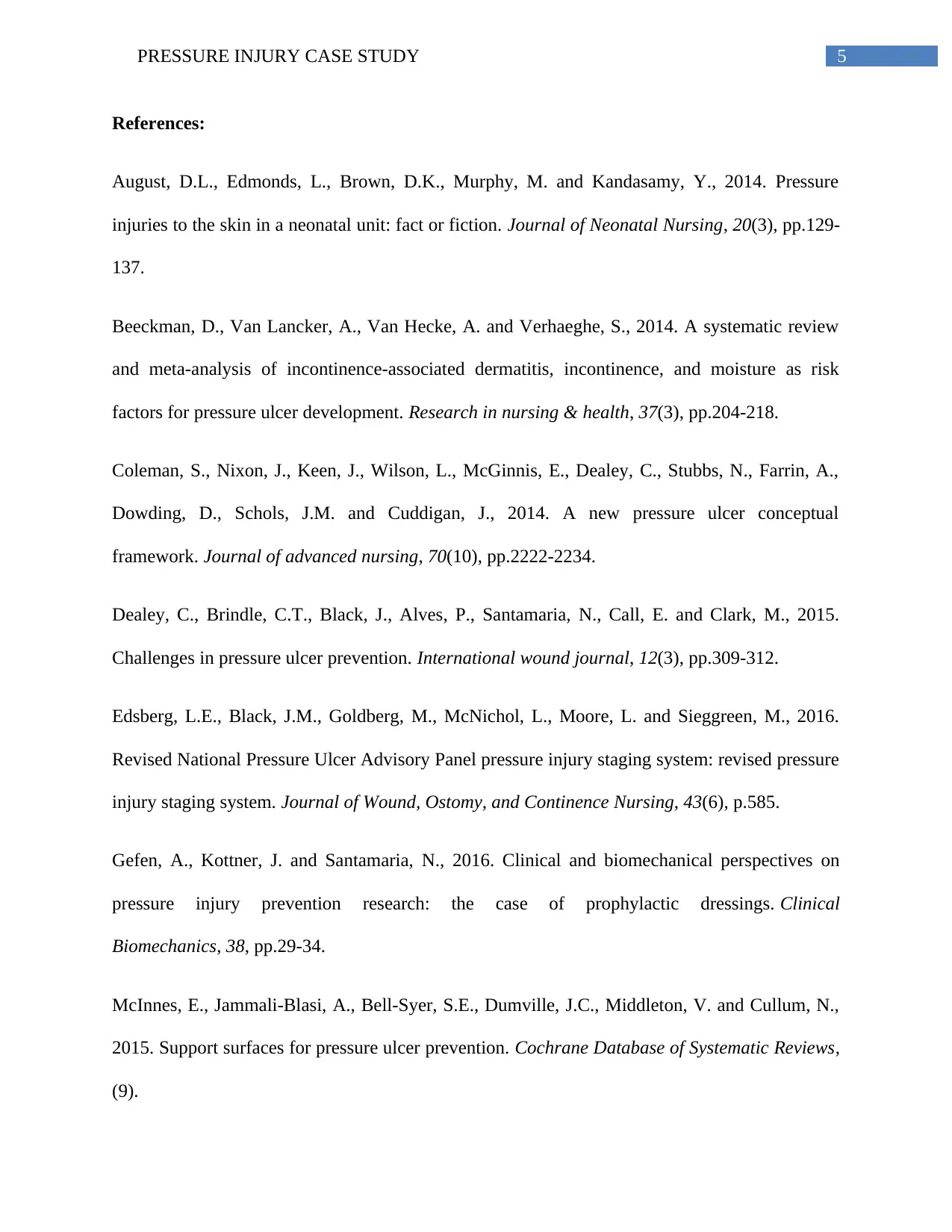
5PRESSURE INJURY CASE STUDY
References:
August, D.L., Edmonds, L., Brown, D.K., Murphy, M. and Kandasamy, Y., 2014. Pressure
injuries to the skin in a neonatal unit: fact or fiction. Journal of Neonatal Nursing, 20(3), pp.129-
137.
Beeckman, D., Van Lancker, A., Van Hecke, A. and Verhaeghe, S., 2014. A systematic review
and meta‐analysis of incontinence‐associated dermatitis, incontinence, and moisture as risk
factors for pressure ulcer development. Research in nursing & health, 37(3), pp.204-218.
Coleman, S., Nixon, J., Keen, J., Wilson, L., McGinnis, E., Dealey, C., Stubbs, N., Farrin, A.,
Dowding, D., Schols, J.M. and Cuddigan, J., 2014. A new pressure ulcer conceptual
framework. Journal of advanced nursing, 70(10), pp.2222-2234.
Dealey, C., Brindle, C.T., Black, J., Alves, P., Santamaria, N., Call, E. and Clark, M., 2015.
Challenges in pressure ulcer prevention. International wound journal, 12(3), pp.309-312.
Edsberg, L.E., Black, J.M., Goldberg, M., McNichol, L., Moore, L. and Sieggreen, M., 2016.
Revised National Pressure Ulcer Advisory Panel pressure injury staging system: revised pressure
injury staging system. Journal of Wound, Ostomy, and Continence Nursing, 43(6), p.585.
Gefen, A., Kottner, J. and Santamaria, N., 2016. Clinical and biomechanical perspectives on
pressure injury prevention research: the case of prophylactic dressings. Clinical
Biomechanics, 38, pp.29-34.
McInnes, E., Jammali‐Blasi, A., Bell‐Syer, S.E., Dumville, J.C., Middleton, V. and Cullum, N.,
2015. Support surfaces for pressure ulcer prevention. Cochrane Database of Systematic Reviews,
(9).
References:
August, D.L., Edmonds, L., Brown, D.K., Murphy, M. and Kandasamy, Y., 2014. Pressure
injuries to the skin in a neonatal unit: fact or fiction. Journal of Neonatal Nursing, 20(3), pp.129-
137.
Beeckman, D., Van Lancker, A., Van Hecke, A. and Verhaeghe, S., 2014. A systematic review
and meta‐analysis of incontinence‐associated dermatitis, incontinence, and moisture as risk
factors for pressure ulcer development. Research in nursing & health, 37(3), pp.204-218.
Coleman, S., Nixon, J., Keen, J., Wilson, L., McGinnis, E., Dealey, C., Stubbs, N., Farrin, A.,
Dowding, D., Schols, J.M. and Cuddigan, J., 2014. A new pressure ulcer conceptual
framework. Journal of advanced nursing, 70(10), pp.2222-2234.
Dealey, C., Brindle, C.T., Black, J., Alves, P., Santamaria, N., Call, E. and Clark, M., 2015.
Challenges in pressure ulcer prevention. International wound journal, 12(3), pp.309-312.
Edsberg, L.E., Black, J.M., Goldberg, M., McNichol, L., Moore, L. and Sieggreen, M., 2016.
Revised National Pressure Ulcer Advisory Panel pressure injury staging system: revised pressure
injury staging system. Journal of Wound, Ostomy, and Continence Nursing, 43(6), p.585.
Gefen, A., Kottner, J. and Santamaria, N., 2016. Clinical and biomechanical perspectives on
pressure injury prevention research: the case of prophylactic dressings. Clinical
Biomechanics, 38, pp.29-34.
McInnes, E., Jammali‐Blasi, A., Bell‐Syer, S.E., Dumville, J.C., Middleton, V. and Cullum, N.,
2015. Support surfaces for pressure ulcer prevention. Cochrane Database of Systematic Reviews,
(9).
⊘ This is a preview!⊘
Do you want full access?
Subscribe today to unlock all pages.

Trusted by 1+ million students worldwide
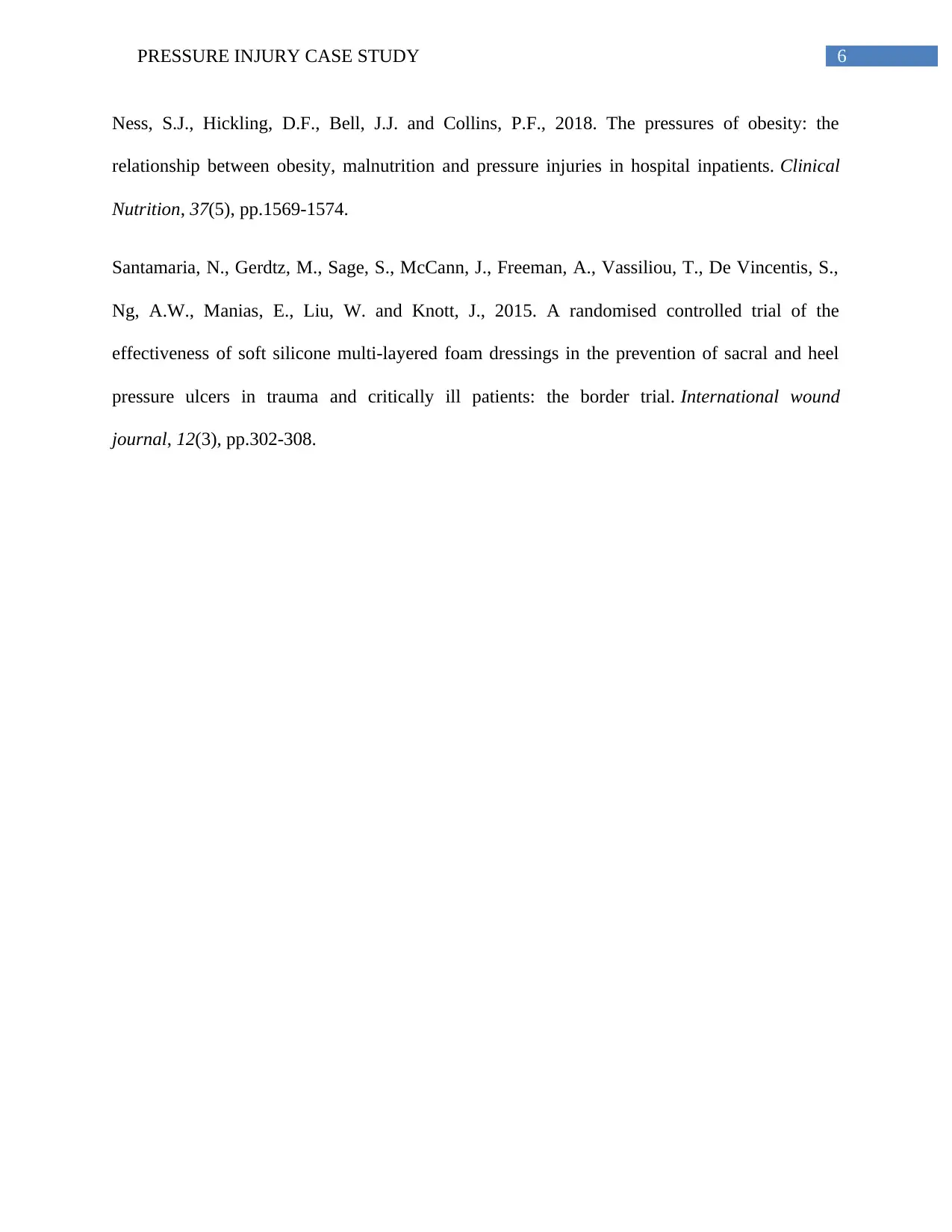
6PRESSURE INJURY CASE STUDY
Ness, S.J., Hickling, D.F., Bell, J.J. and Collins, P.F., 2018. The pressures of obesity: the
relationship between obesity, malnutrition and pressure injuries in hospital inpatients. Clinical
Nutrition, 37(5), pp.1569-1574.
Santamaria, N., Gerdtz, M., Sage, S., McCann, J., Freeman, A., Vassiliou, T., De Vincentis, S.,
Ng, A.W., Manias, E., Liu, W. and Knott, J., 2015. A randomised controlled trial of the
effectiveness of soft silicone multi‐layered foam dressings in the prevention of sacral and heel
pressure ulcers in trauma and critically ill patients: the border trial. International wound
journal, 12(3), pp.302-308.
Ness, S.J., Hickling, D.F., Bell, J.J. and Collins, P.F., 2018. The pressures of obesity: the
relationship between obesity, malnutrition and pressure injuries in hospital inpatients. Clinical
Nutrition, 37(5), pp.1569-1574.
Santamaria, N., Gerdtz, M., Sage, S., McCann, J., Freeman, A., Vassiliou, T., De Vincentis, S.,
Ng, A.W., Manias, E., Liu, W. and Knott, J., 2015. A randomised controlled trial of the
effectiveness of soft silicone multi‐layered foam dressings in the prevention of sacral and heel
pressure ulcers in trauma and critically ill patients: the border trial. International wound
journal, 12(3), pp.302-308.
1 out of 7
Related Documents
Your All-in-One AI-Powered Toolkit for Academic Success.
+13062052269
info@desklib.com
Available 24*7 on WhatsApp / Email
![[object Object]](/_next/static/media/star-bottom.7253800d.svg)
Unlock your academic potential
Copyright © 2020–2025 A2Z Services. All Rights Reserved. Developed and managed by ZUCOL.





